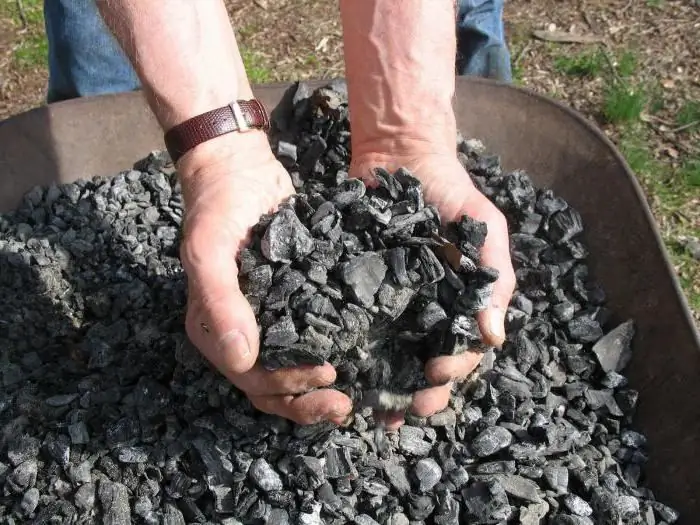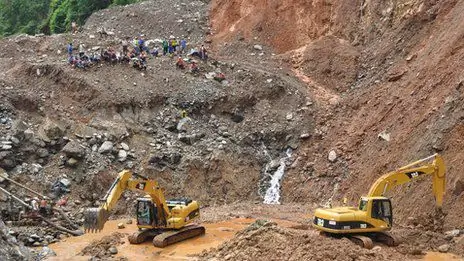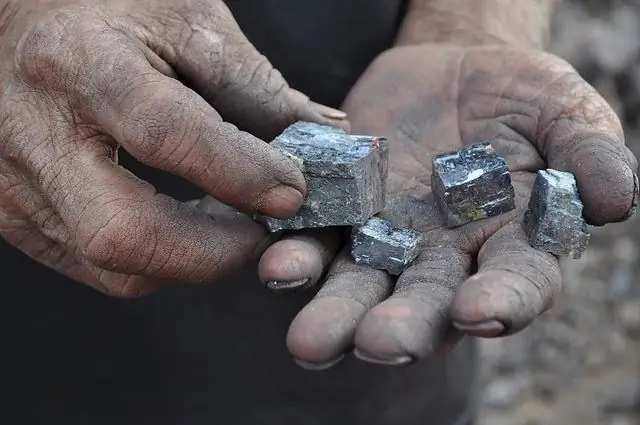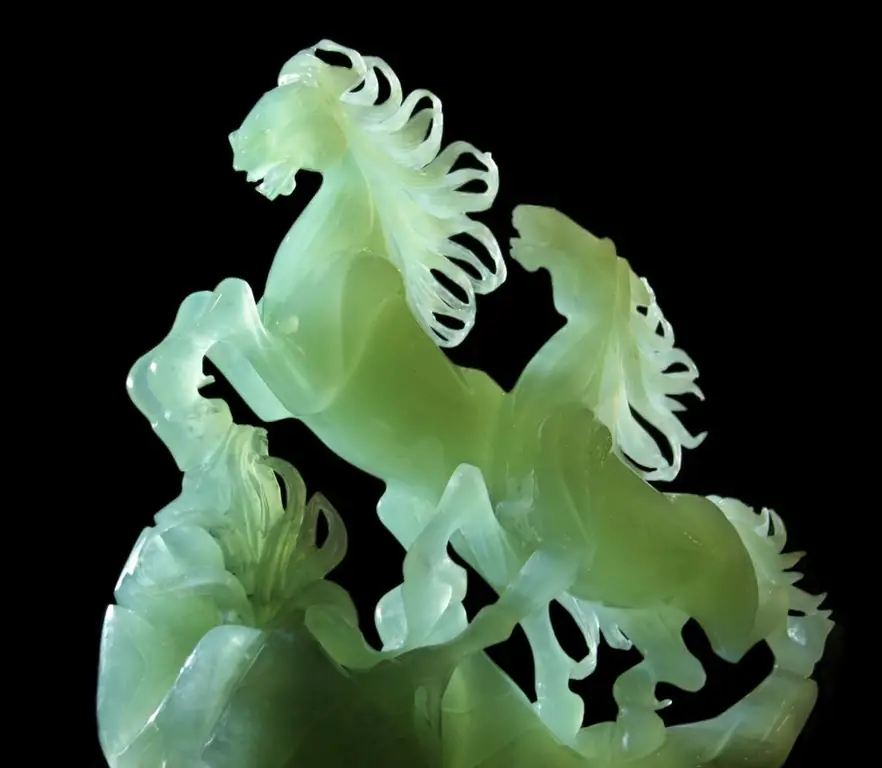2026 Author: Howard Calhoun | [email protected]. Last modified: 2025-01-24 13:10:45
The total number of jade deposits in the world does not exceed fifty. Most often, this ornamental mineral forms small outcrops from the earth's crust, which in appearance resemble other rocks. The rarity of jade is explained by the peculiarities of its formation. In Russia, the deposits of Buryatia and Transbaikalia are the most promising. This mineral is highly valued in Asian countries, especially in China, where prices for it reach several thousand dollars per kilogram.
Nature jade

Jade is a mineral of hydrothermal-metasomatic origin. Such rocks occur at shallow depths in the earth's crust, and their formation occurs under the influence of high pressure and hot mineralized aqueous solutions that circulate under the surface of the earth. The most common color is green, but there are others - white, gray, brown, black, yellowish, reddish and blue (the rarest).
In nature, this mineral is quite rare, industrial interestrepresent primary deposits and boulder placers. Since ancient times, a person has developed a special relationship with this stone. It was mined in the Neolithic era, and in China it is considered sacred to this day. Information about jade deposits was kept secret. Over time, many of them were forgotten. Therefore, in the XX century. geologists had to rediscover them.
In this regard, many may wonder if jade is mined in Russia. Officially, mineral deposits were discovered in 1824 in the Eastern Sayan, and only 27 years later the first batch with a total weight of about 2 tons was mined there. After another 11 years, products from domestic jade were exhibited at the world exhibition in London.
The microstructure of the mineral has a tangled-fibrous character, it is very difficult to split it. Therefore, in the past, people mainly collected it in mountain rivers, after the snow cover had melted. Jade was then perceived as a gift of nature, mined in hard-to-reach places.
Industrial types
Jade deposits in Russia are confined to alpine-type ultramafic rocks (parts of the mantle embedded in the earth's crust) and dolomite marbles, or rather, to the contact of two rocks of contrasting composition. Chemically non-equilibrium rocks exchange elements between each other, which leads to recrystallization. There is a hypothesis that this mineral is formed during the movement of serpentinites along tectonic faults. This is also confirmed by the fact that relict serpentinites are found in jade.
There are two main industrial types of minerals - aposerpentinite(formed at the border with serpentinites and aluminosilicate rocks) and apocarbonate (at the contact of dolomitic marbles with granitized aluminosilicate rocks).
The last type of jade is characterized by light tones of color (from salad to pure white). They are much less common. About where white jade is mined in Russia is described below. Demand for them on the gem market has been constantly growing in recent decades and significantly exceeds supply, which explains the high price of the mineral (up to 10,000 US dollars per 1 kg). The color of the stone depends on the inclusions of iron and chromium. A large amount of iron gives it a dark color, and chromium - emerald green.
Application

In the Neolithic era, jade was used to make knives, axes, arrowheads and spears, various amulets, figurines and jewelry were carved from it. This stone served as a hallmark of high position.
Jade stone-cutting and jewelry business flourished in China in the 17th and 18th centuries. Bowls, chess, animal figurines, balls, attributes of imperial power were sharpened from it. At that time, the mineral was valued above gold, and plaques made from it were used instead of money.
In Russia, jade is mined for use in jewelry (making inserts in silver and gold items, cabochons, beads, balls and figurines), as well as for export. A distinctive feature of the mineral is its increased strength, surpassing that of steel. At the same time, jade hasrelatively low hardness (5.5-6 units on the Mohs scale), which makes it easy to process it by cutting and polishing. The "viscosity" of the stone makes it possible to make very complex carvings with many curved surfaces.

Jade is practically the only material from which durable jewelry rings can be made. Other stones break quickly when worn, as they do not resist stretching well. In the days of Tsarist Russia, stone-cutting factories also made caskets, cigarette cases, toilet utensils, plates and other items from it. But most of all, this stone is revered in China, where jade products are passed down from generation to generation as a family heirloom, huge collections are collected, works of art are created, and even festivals are dedicated to this mineral.
Discovery of deposits
The first deposits where jade was mined in Russia were located on the Onot River. It flows through the territory of Buryatia and the Irkutsk region and is one of the largest rivers of the Eastern Sayan. At the end of the XIX century. mining engineer Yachevsky found the first indigenous vein on the Khara-Zhalga stream, and in the 30s. 20th century Soviet geologist Shestopalov discovered jade veins on the Ilchir and Khusha-Gol rivers. All these rivers are located in the Okinsky district of Buryatia. These hard-to-reach mountainous and gorge places are sparsely populated to this day.
There are two main deposits where jade mining in Russia has reached a large industrial scale: Ospinskaya (Ilchir river basin) and Ulan-Khodinskaya. in the Baikal-Sayan provincea number of mineral deposits located on a relatively small area:
- Gorlykgolskoye (Khusha-Gol River) is the largest, but the quality of jade is low.
- Arahushanzhalginskoye - loose large-boulder.
- Bortogolskoye.
- Zunospin (fully worked out at the moment).
- Khamarkhudinskoe - jade smoky gray with a yellowish or greenish tint.
- Kharganty.
- Khangarul.
- Khokhyurt (Khokhyurta river).
- Boldoktinskoe (R. Boldokto) - alluvial deposit, and others.
Modern large deposits
Currently, 98% of jade reserves are located in three areas:
- Vostochno-Sayansky (Ulankhodinskoye, Zunospinskoye, Ospinskoye, Gorlykgolskoye, Arakhushanshalginskoye deposits).
- Dzhidinsky (along the rivers Boldokto, Khokhurta, Ukhabyr).
- Vitimsky (Buromskoye, Golyubinskoye deposits).
In total, about eighty veins of jade and dozens of its placers were found in the Eastern Sayan mountain system and in Transbaikalia.
Ospinskoye and Ulankhodinskoye deposits

The best veins of jade stone in Russia were discovered at the Ospinsky deposit. Minerals of this origin are characterized by a bright apple-green color, as well as the effect of a "cat's eye". The field consists of two sections - Ilchirsky and Ospinsky, located at a distance of 1 km from each other. 9 nephrite-bearing veins were found here. The sixth of them,high-quality jade (large pieces up to 1 m3 without cracks and inclusions) was developed until 2011
Ulankhodinskoye field. At present, it can only be considered in a historical aspect, since it has been fully developed, like the Zunospinskoye. The quality of the jade is lower than that of the Ospin deposit. Development was carried out on the northern slope of the Ulan-Khoda mountain and in the upper reaches of the Khara-Zhelga river.
Udokan field

The Udokanskoye deposit is located in the Trans-Baikal Territory, on the Tsipa River (left tributary of the Vitim) in the north of Buryatia (Bauntovsky district). To a greater extent, it has also been worked out. A feature of the extraction of jade in Russia at this deposit is that olive-yellow minerals were found here, approaching in their decorative properties to "golden" (or "honey") jade, which is very rare and is valued more than white.
Minerals of light green color predominate in the deposit, and their main defect is fracturing, which causes small sizes of mined blocks. Here, in the basin of the Kalar River, boulders and pebbles of high-quality white jade were found. The cost of this stone, mined in the Bauntovsky Evenk region of Buryatia, reaches $5,000 per kilogram, which exceeds the price of gold. Other deposits of white jade are known only in China, Australia, and in Russia this stone was also found in the middle reaches of the Vitim River.
Jades of Altai

Altai nephrites were discovered in the 60s. 20th century The deposits are small in size and located in the following locations:
- Charysh-Terektinsky deep fault (Terektinsky ridge) - from the village of Kaitanak to the Koir River (Akkem, B altyrgan, Aryskan, Tomul, Muinokh manifestations, which are located mainly near streams);
- Kurai Rift;
- Shalapsky fault;
- Akkem river (Chagan-Uzun village), Cheremshanka.
Altai minerals of poor quality: dirty green, fractured. According to some estimates, the total reserves of jade in Altai are about 200 tons.
Small deposits where jade is mined in Russia
Small jade deposits have also been found in the following regions:
- in the Republic of Tuva (Bilinsky deposit);
- in the South Urals (Naraly Mountains);
- in Bashkortostan (Uchalinsky district, Nizhny Iremel river);
- in the Chelyabinsk region (mountain Bolshoy Bikilyar)
- in the Republic of Sakha (Selennyakh River);
- in the north of Kamchatka (Kuyul massif).
In these places, the mineral is also of low quality, usually greenish marsh color.
Methods of mining

Deposits where jade is mined in Russia are developed using 2 methods:
- Open pit in quarries using heavy equipment (bulldozers, excavators). In Buryatia, about 90% of all nephrites are obtained this way. Raw materials are exported along taiga roads, winter roads (roads thatoperated only in winter) or helicopters.
- Collecting pellets (boulders and pebbles) at the bottom of rivers. This is the most dangerous method of extraction, but this type of raw material is highly valued - its price is ten times higher than the price of a mineral mined in a quarry. These works require scuba gear, compressors and highly qualified divers.
Recommended:
Coal: mining in Russia and in the world. Places and methods of coal mining

The coal mining industry is the largest segment of the fuel industry. Every year, the level of coal production increases all over the world, new technologies are mastered, equipment is improved
Gem mining: types and methods, deposits

Gemstone jewelry has been invented since before our era. But in those days, their extraction of the ball was more spontaneous than planned. Mankind began to extract precious natural minerals recently, by the standards of history, of course
How copper is mined: methods, history and deposits

How is copper mined? The answer to this question in our time is several technologies. Usually, ore containing this metal is mined first by a quarry or mine method. Further, such material is enriched to blister copper, and then further purified
Gold mining. Gold mining methods. Mining gold by hand

Gold mining began in ancient times. In the entire history of mankind, approximately 168.9 thousand tons of precious metal have been mined, almost 50% of which goes to a variety of jewelry. If all the mined gold is collected in one place, then a cube would be formed as high as a 5-storey building, having an edge - 20 meters
Silver mining: ways and methods, main deposits, leading countries in silver mining

Silver is the most unique metal. Its excellent properties - thermal conductivity, chemical resistance, electrical conductivity, high ductility, significant reflectivity and others have brought the metal to be widely used in jewelry, electrical engineering and many other branches of economic activity. For example, mirrors in the old days were made using this precious metal. At the same time, 4/5 of the total produced volume is used in various industries

